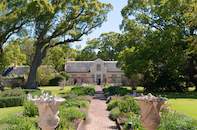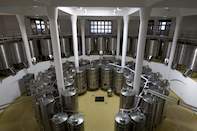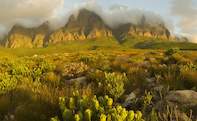‘I saw this estate with exceptional pleasure since everything there was laid out wonderfully finely,’ wrote Reverend François Valentijn of Vergelegen in 1705. Follow in his footsteps, as have Nelson Mandela, Queen Elizabeth II and others.
Preserved for Public Pleasure

‘For 300 years only certain governors, slaves, priests, philanthropists, scoundrels, lovers, insolvents, peacemakers and murderers were able to take in the breathtaking views of Vergelegen… Now it’s your turn.’ These framed words remind custodians of this cultural and agricultural jewel, from corporate owners Anglo American plc to farm and restaurant managers and staff, what their labours are all about.
It is their task not only to realise Vergelegen’s potential as one of the Cape’s finest wine farms, but to place its rich cultural heritage firmly in the public domain. It takes a full day to absorb all Vergelegen has to offer, but it will be a day to remember.
In 1700 the Cape’s Dutch colonial governor Willem Adriaan van der Stel was granted the land on which Vergelegen, Kubla Khan’s ‘stately pleasure-dome, was to be established.
The grandeur of his undertaking - and the fact that public funding was used to finance it - were instrumental in the downfall of van der Stel just six years later, even though the estate also functioned as experimental farming, and viticultural, project.
The farm’s fortunes waxed and waned over the next three centuries under private ownership. When mining giant Anglo American bought it in 1987, it set about resurrecting Van der Stel’s original vision.
Designed for the Future

The 3000-hectare property is made up of forest, pasture, orchards, vineyards, gardens and natural vegetation in an amphitheater created by the dramatic Hottentots Holland and Helderberg mountain ranges.
As you cross the Lourens River into the estate, you’ll see the white cellar on a coronet on a distant vine-clad hill. A guided tour through the vineyards will take you to it.
A structural masterpiece, the winery is sunk into the hill and, to facilitate the gentle handling of grapes and wine through gravitational flow, it operates on four levels: grape intake on the top level, red wine fermenters on the second, stainless steel tanks on the third and the barrel maturation cellar deep underground. Its octagonal shape mirrors Van der Stel’s plan for the walled gardens around the homestead below.
Only some 130 hectares of the best viticultural land in this sweeping landscape were earmarked for growing grapes: white varieties on the cool south-facing slopes, and the red on the warmer west-facing aspects. The approach to selecting sites has been scientific from the start, and research into terroir is ongoing.
The unequivocal aim was to produce benchmark Cape wines comparable with the French classics and modern New World powerhouses and, while this has arguably in several cases been achieved, the work continues.
Long-time cellarmaster André van Rensburg has developed an extensive but carefully curated portfolio of highly rated wines, headed by the flagship trio: the Vergelegen V Bordeaux-style red blend and the Vergelegen GVB Red and GVB White, also styled as Cape Bordeaux.
Classic Bordeaux red varieties dominate the Reserve and Vineyard ranges, together with Shiraz (always a Van Rensburg strong point), while classic Bordeaux (Semillon and Sauvignon Blanc) and Burgundy (Chardonnay) varieties produce the farm’s showcase white wines.
Some 40 hectares replanted early in the 2000s in an effort to eradicate South African vineyards’ ubiquitous leaf-roll virus heralded the beginning of a total replanting programme: some 74 000 vines are regularly spot-checked and at the first sign of disease, the infected vine and its immediate neighbours are replaced.
Not only did the re-infection rate slow to a mere one vine in 4000, but building on experience and familiarity with conditions the replanting has allowed row directions to be changed so that wind effects and exposure to the sun on these high-lying slopes could be regulated.
Nature Reclaimed

A 10-year land-management programme resulted in Vergelegen being nominated the first BWI (Biodiversity & Wine Initiative) Champion in sustainable, eco-friendly wine farming.
Alien vegetation is being cleared on a large scale to allow the regrowth of natural mountainside vegetation, and parts of Schaapenberg hill have been preserved to protect indigenous renosterveld. The small herd of bontebok beside the road heralds the re-introduction of larger fauna to join the small buck, caracal and other wildlife.
The tasting room, the gift shop and interpretive centre with displays of Vergelegen’s history and role in Cape winemaking are housed in three restored thatched stables around a courtyard. Cellar, vineyards and garden tours are also available.
There is still more to the immediate home farm precinct that Van der Stel envisioned in 1700. Much of it is given over to large trees and gardens. The camphor forest, grown from saplings of Vergelegen’s iconic manor house specimens, accommodates picnics, compiled from a menu, at elegant tables placed in secluded glades.
The gardens are thematic, ranging from traditional octagonal, rose and reflective pool areas, to wetlands, fynbos and hydrangea gardens. There is a yellowwood walk, an oak arboretum and a rare camellia collection of over 300 species representing one of only 39 internationally recognised ‘gardens of excellence’.
Herb and kitchen gardens supply the farm’s eateries, from Vergelegen’s traditional Camphor Restaurant with its elegant indoor and terraced dining (re-located to the riverside River Café glass marquee during a recent revamp) to family-friendly, bistro-styled The Stables with views of vineyards and the imposing Hottentots Holland Mountains.
And dominating all, on the lawn in front of the 18th-century Cape Dutch manor house, are the five carefully tended and treasured giant camphor trees that Van der Stel planted more than 300 years ago. The restoration and modern incarnation of Van der Stel’s original ‘model farm’ earned Vergelegen recognition in 2019 as a Provincial Heritage Site and a nomination for World Heritage Site status.
 The southern part of the Stellenbosch winelands is dominated by the Stellenbosch and Helderberg mountains and, further south, by the magnif...
The southern part of the Stellenbosch winelands is dominated by the Stellenbosch and Helderberg mountains and, further south, by the magnif...